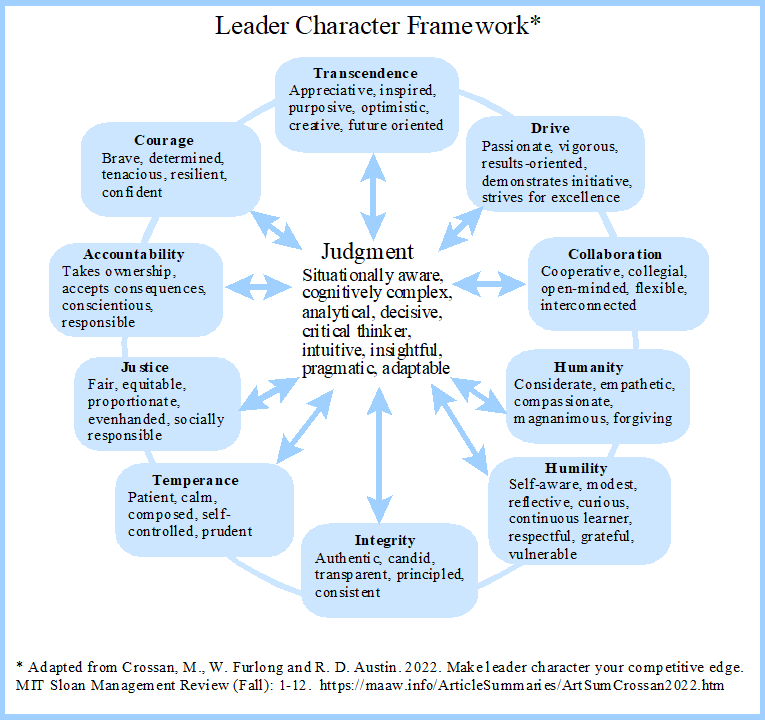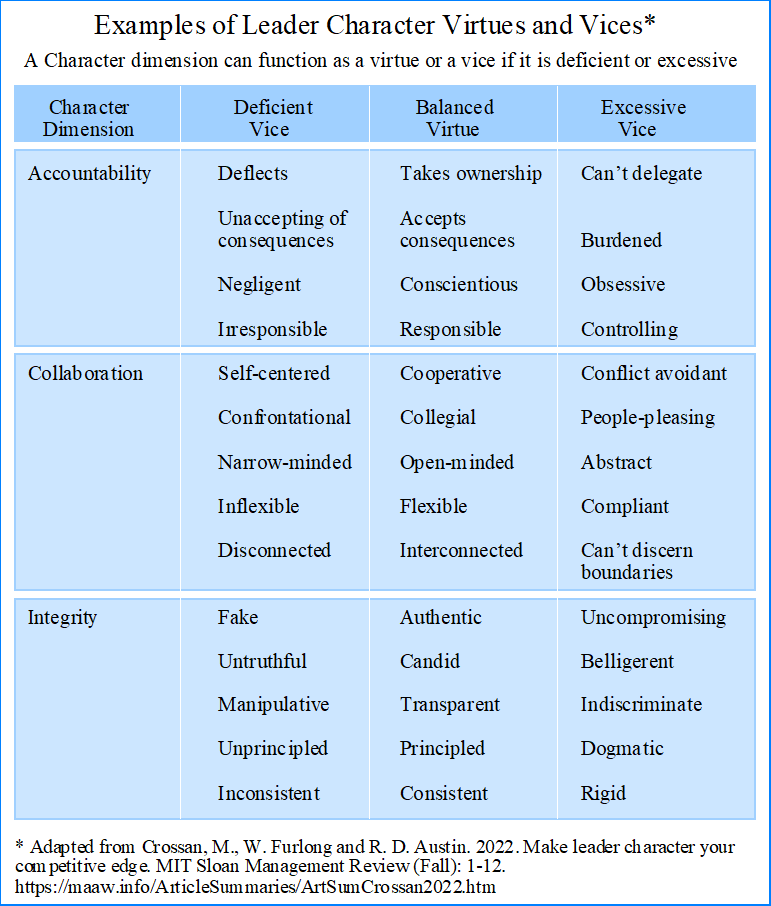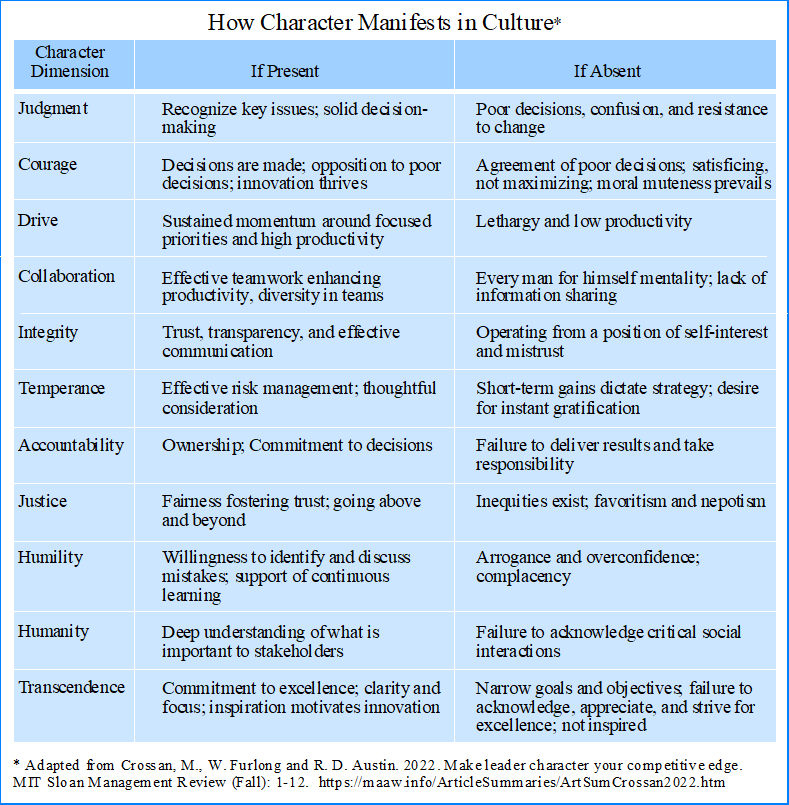
Summary by James R. Martin, Ph.D., CMA
Professor Emeritus, University of South Florida
How
to Manage Yourself Main Page |
Leadership Main Page
Many people tend to underestimate and misunderstand the concept of character and view it as ethics rather than recognizing it as the foundation of all judgment and decision-making. Many also believe character is a fixed trait although it can be developed, embedded and scaled in their organization and culture. Superior performance as well as misconduct and poor decision making are all the result of character-based judgment at all levels within the organization. The purpose of this article is to provide a leader character framework to show what character is, why it matters, how it can be developed, and how it is revealed by people's actions.
Understanding Leader Character
To build on the underlying research on character and leadership practice the authors used focus groups involving over 2,000 executives. This lead to a definition of leader character based on ten separate dimensions that interact with the central quality of judgment. The resulting leader character framework is illustrated below.

The following table shows that each dimension in the leader character framework is a potential virtue or vice depending on whether it is balanced, deficient or excessive. For example, in the accountability dimension taking ownership, accepting consequences, and being conscientious and responsible are virtues. On the other hand, not accepting consequences and being negligent and irresponsible are deficient vices, while not delegating, being burdened, obsessive, and controlling are excessive vices. Vice behaviors are often treated as personal styles rather than causes of poor decision-making and negative outcomes.

It is important to recognize that the dimensions of character are not independent, but instead work together. Excess is having too much of one dimension relative to other dimensions. For example, courage needs to be balanced by temperance to avoid recklessness, but supported by justice and accountability. Character development seeks to build character, or restore deficient and excessive character dimensions to a virtuous state. The elements of character are virtuous habits that can be developed. The development of character includes five phases.
1. Discover - Provide an overview of leader character to help individuals discover latent character strengths upon reflection.
2. Activate - We are not born with character. Just as physical exercise builds muscle strength, a person's intelligent and disciplined practice develops character strength. Character can be activated through reminding, priming, and reinforcement. There are many ways to do this. For example listening to music can motivate exercise and motivate character development as well (See the Virtuosity Playlist on Spotify). Leaders are responsible for developing an organization wide system for elevating character and integrating it with competence.
3. Strengthen - The authors developed a Character Behavior Index that measures the intention to develop character-related behavior. There is also a Virtuosity learning app that provides a customized program for the learner to strengthen character.
4. Connect - This phase reinforces the interconnections of the character dimensions.
5. Sustain - Sustaining character means that a person can use any dimension of character when it is needed, but not all the time.
Making Leader Character a Strategic Asset
Organizations need to apply character insights to policies and practices such as hiring, rewarding, and promoting individuals with strong virtuous characters. The following illustration provides examples of typical behaviors in organizations where leader character is either present or absent.

Companies need to understand what the dimensions of character are, how to develop them, and how they are nested within the other dimensions of character. The key is to elevate leader character together with competence so that aspirational values do not evolve into dysfunctional behavior. The organization's culture is a reflection of the leaders' character.
Taking Action on Character
There are many ways for organizations to get started including leadership workshops and webinars that can provide participants with an immediate grasp of how leader character can be applied on both a personal and professional level. Video clips such as the story of Nelson Mandela's transformation in South Africa are also useful. A profound moment takes place when people realize that their strength of character is the basis of their leadership potential as well as their personal relationships outside the workplace.
Everyone should begin with a self assessment and consider where they need to strengthen the dimensions of their character. For example, question whether your potential virtues are operating like vices. Question how your character appears to others and affects other people? Embed leader character into your behavior from wherever you are in the organization's hierarchy. Build your character along with your competence. Elevating character along with competence is both a strategic imperative and a social responsibility.
________________________________________________
Related summaries:
Anonymous. 2019. A Warning: A Senior Trump Administration Official. Twelve: Hachette Book Group. See Chapter 2: The Character of a Man. (Summary).
Deming, W. E. 1993. The New Economics For Industry, Government & Education. Massachusetts Institute of Technology Center for Advanced Engineering Study. (Summary).
Drucker, P. F. 2005. Managing oneself. Harvard Business Review (January): 100-109. (Summary).
Kaplan, R. S. 2008. Managing yourself: Reaching your potential. Harvard Business Review (July-August): 45-49. (Summary).
Roberts, L. M., G. Spreitzer, J. Dutton, R. Quinn, E. Heaphy and B. Barker. 2005. How to play to your strengths. Harvard Business Review (January): 74-80. ("You may have more to gain by developing your gifts and leveraging your natural skills than by trying to repair your weaknesses. Here is a systematic way to discover who you are at your very best." When using the Reflected Best Self exercise, you seek only positive feedback.). (Summary).
Schoemaker, P. J. H., S. Krupp and S. Howland. 2013. Strategic leadership: The essential skills. Harvard Business Review (January/February): 131-134. (Self Test on Strategic Leadership).